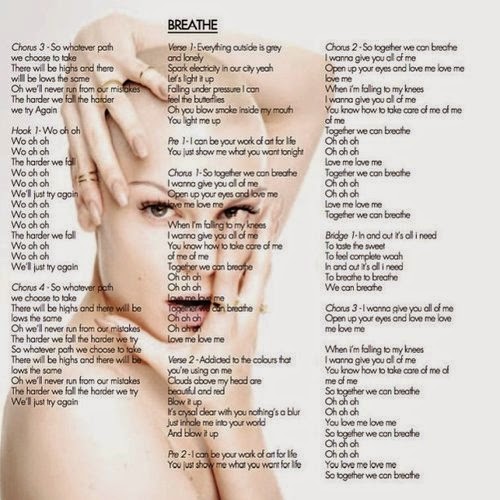Front
- Main image (usually close ups)
- Title of album
- Name of artist
- A recognisable logo or font that is associated with the artist
What I have noticed about album covers is they tend to have a central image the artist on the front panel, this is especially true of Pop albums. Solo artists are more likely to have their image at the front as they are trying to promote their music by promoting their appearance. This is done to make the buyer feel like they are close to the artist and allows them to form a deeper connection. The star is made to be the most prominent image with little distractions in background; this is done to emphasise the dominance of the artist and create a stronger star image. This is especially true of female artists who use their sexuality as a selling point to attract male audiences.
Groups and bands are presented slightly differently; while one close up is used of a solo artist the same cannot be done for a group album. Instead they model the group in a variety of heights and poses to create individual images for each member. Some may be standing/sitting/jumping etc. and they will most likely be wearing different items of clothing; this is done to expresses their individuality and allows the audience to identity with one member. While there may be a theme amongst the album e.g. the black clothing on the JLS album or the boom boxes in The Saturdays album, they each have an individual personality that is expressed through their clothing and staging.
However, not all album covers follow the typical conventions. Some artists reject the idea of having their image on the album cover. This could be done for a few reasons; they feel the attention for their album should come from their music and not their appearance. Or it could be they would like their music to be represented by a symbol. These albums tend to be targeted at older audiences of 17-25 as they should be at the level of maturity to not to attracted to something based on its look.
The Arctic Monkeys album cover image is of sound-waves; this follows the genre of their music which is supposed to be alternative/indie; it demonstrates they're not going to be mainstream and use an image of their faces, instead they choose to be represented by that one symbol. Lorde's album cover features her name and album name on a black background. It is a very simple album cover but it has a strong meaning. This is Lorde proclaiming she is only in it for the music, you don't need to like my face or approve of the way I dress, but listen to me sing.
Back
- Track list
- Special Features
- Another predominant image
The back of an album usually features a lot of graphics and possibly another predominant image of the artist. The typography usually signifies the genre of the album; special fonts and colours will be used to identify the genre.
Institutional Information
- Price
- Barcode
- Record Label
- Year of publishing
- Copyright
- Individual track writers, composers, engineers, producers
- A reference number
- Band members
- Guest performers
Spine
- Name of artist
- Title of album
- Record Label
- Reference number
Inserts
- Further institutional information for each individual track
- Song lyrics
- Photographs of artist
- Thankyous
Purpose of an Album Cover
- To protect the album
- To advertise the contents
- Using the artistic design to reflect the creative intentions of artists
- To reflect the principles, attitudes etc of Record Label
- To stand out, to be interesting, to be eye-catching
- To boost sales, enhance profit
- Attracts on retail shelves
- Enables product to be resold through different modes
- Art becomes the icon















No comments:
Post a Comment